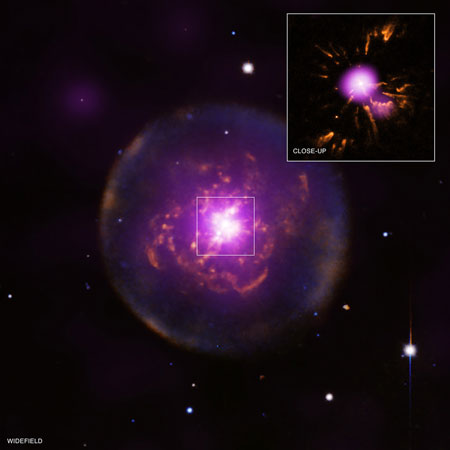| Nov 15, 2012 |
Born-again star foreshadows fate of Solar System
|
|
(Nanowerk News) Astronomers have found evidence for a dying Sun-like star coming briefly back to life after casting its gassy shells out into space, mimicking the possible fate our own Solar System faces in a few billion years ("Rebirth of X-ray Emission from the Born-again Planetary Nebula Abell 30").
|
|
This new picture of the planetary nebula Abell 30, located 5500 light-years from Earth, is a composite of visible images from the NASA/ESA Hubble Space Telescope and X-ray data from ESA’s XMM-Newton and NASA’s Chandra space telescopes.
|
 |
| Abell 30: a born-again planetary nebula. Credits: Main image: X-ray: ESA/XMM-Newton; optical: NSF/NOAO/KPNO; inset: NASA/CXC/IAA-CSIC/M. Guerrero et al; optical: NASA/STScI
|
|
‘Planetary nebula’ is the name given to the often-concentric shells of stellar material cast into space by dying stars. To astronomers of the 18th century, these objects looked like the colourful ‘blob’ of a planet through their telescopes, and the name stuck.
|
|
Astronomers now know that as a star with less than eight times the mass of the Sun swells into a red giant towards the end of its life, its outer layers are expelled via pulsations and winds.
|
|
Ultraviolet radiation shining out from the stripped-down hot stellar core then lights up the ejected shells, resulting in intricate artworks that can be seen by modern telescopes.
|
|
The star at the heart of Abell 30 experienced its first brush with death 12 500 years ago – as seen from Earth – when its outer shell was stripped off by a slow and dense stellar wind.
|
|
Optical telescopes see the remnant of this evolutionary stage as a large, near-spherical shell of glowing material expanding out into space.
|
|
Then, about 850 years ago, the star suddenly came back to life, coughing out knots of helium and carbon-rich material in a violent event.
|
|
The star’s outer envelope briefly expanded during this born-again episode, but then very rapidly contracted again witin 20 years.
|
|
This had the knock-on effect of accelerating the wind from the star to its present speed of 4000 kilometres per second – over 14 million kilometres per hour.
|
|
As this fast stellar wind catches up and interacts with the slower wind and clumps of previously ejected material, complex structures are formed, including the delicate comet-like tails seen near the central star in this image.
|
|
The stellar wind bombarding dense clumps of material provides a chilling look at the possible fate of Earth and its fellow planets in our own Solar System in a few billion years’ time.
|
|
When our Sun emits its final gasps of life at the heart of a planetary nebula, its strong stellar wind and harsh radiation will blast and evaporate any planets that may have survived the red giant phase of stellar evolution.
|
|
If any distant civilisation is watching with high-power telescopes at the time, they might see the glowing embers of the planets light up in X-rays as they are engulfed in the stellar wind.
|

